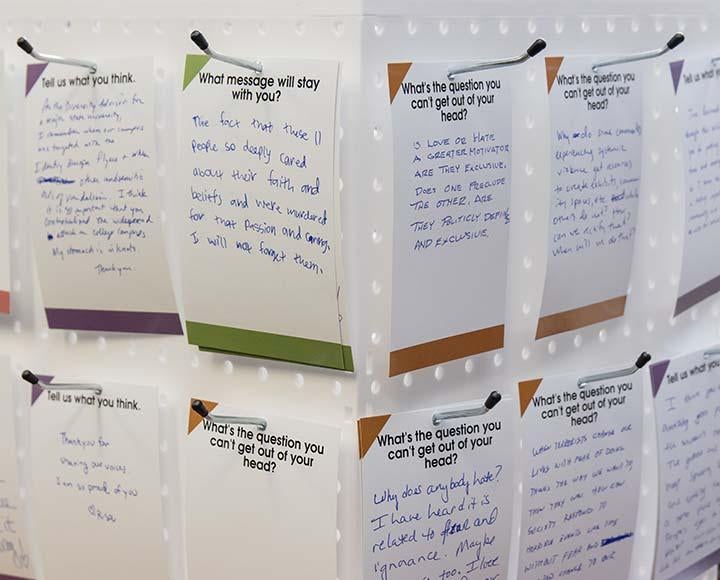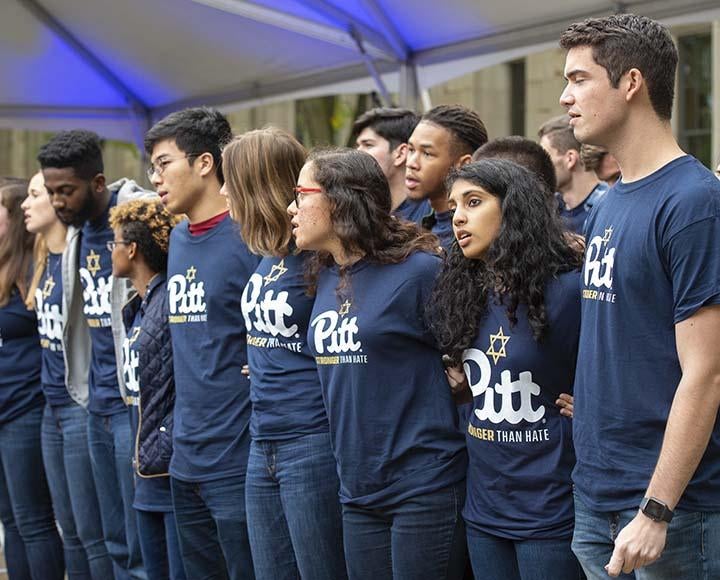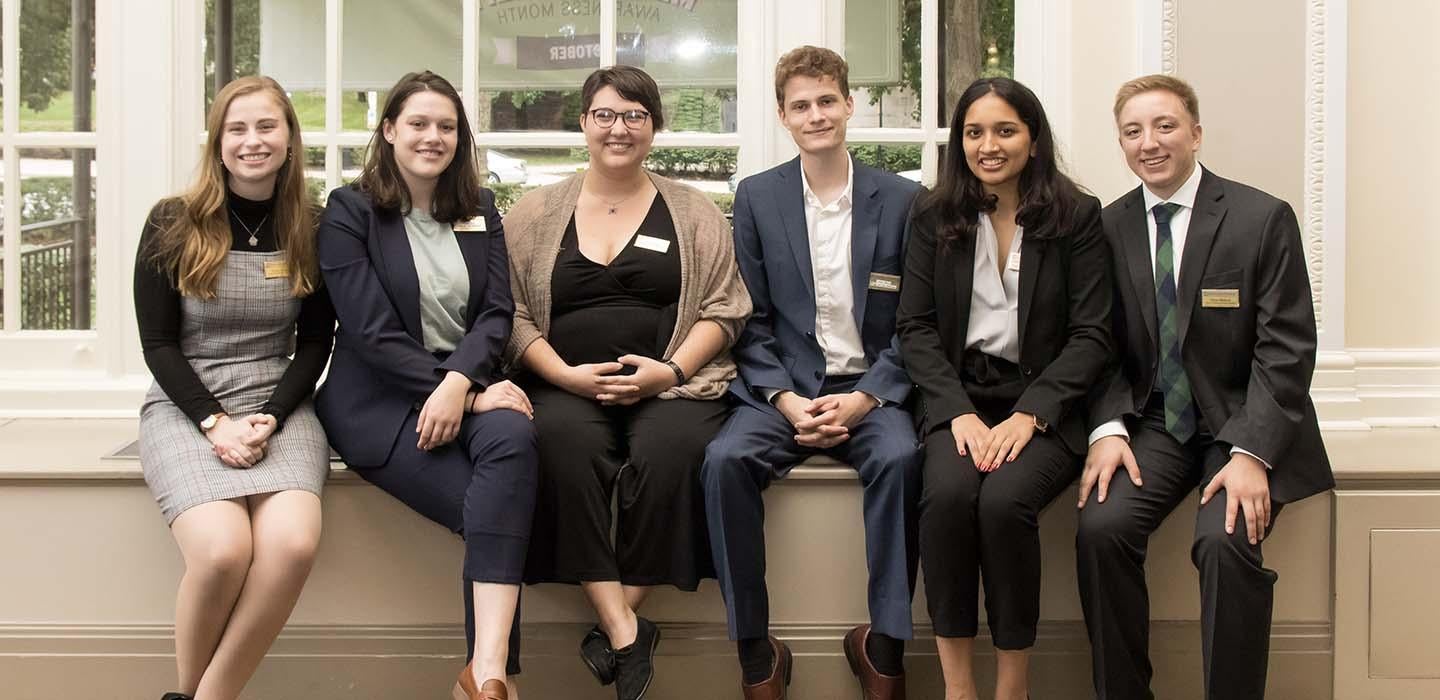
Subscribe to Pittwire Today
Get the most interesting and important stories from the University of Pittsburgh.On Oct. 27, 2018, shock and sadness washed over Pitt’s campus, the city of Pittsburgh and the nation following the attack on the Tree of Life synagogue and its three congregations in Squirrel Hill. Eleven worshippers were killed and six others injured.
“It impressed upon me the immediacy of antisemitism and the relevance it still has,” said Maja Lynn, who today is a Pitt senior majoring in museum studies and anthropology.
Lynn was a first-year student at the time of the deadliest attack on the Jewish community in U.S. history, and before starting classes that fall, she had just spent twelve months as a volunteer at the Dachau Concentration Camp Memorial Site in Germany.
"I spent a year intensely thinking about the Holocaust," she said of the experience leading tours and completing archival research and a short biography of a former Dachau prisoner for the camp’s Book of Remembrance.
"And suddenly this horrific antisemitic attack was happening in real time, so immediate to what I'd been thinking about in a historical context," she said.
In the days that followed, she mourned, for the most part, alone. But eventually, she decided to channel her pain into purpose and community. That spring, she applied for the 2019 Tree of Life Scholars program, sponsored by Pitt’s Office of Undergraduate Research and Pitt’s Jewish Studies Program, as well as the Rauh Jewish Archive at the Heinz History Center and the Holocaust Center of Pittsburgh.
The program sought to collect and display student responses to the shooting.
The resulting collection, To Those Who Grasp It: Student Responses to Oct. 27, was the first attempt in Pittsburgh and possibly beyond, to create an interpretive exhibit to understand and contextualize Oct. 27, said Eric Lidji, director of the Rauh Jewish History Program and Archives within the Senator John Heinz History Center, where the parts of the collection have been housed since August of this year. Other materials from the collection are also on display at the Holocaust Center of Pittsburgh.
“As time passes, it will be a valuable resource for understanding how people — and younger people in particular — understood this event during that first year,” Lidji said. “The stakes were high, and they pulled off their exhibit with grace and sensitivity.”
Curating the collection
With no prior curation experience, Lynn and five other Tree of Life Scholars — Liam Sims (A&S ’21), Emily Dickson (A&S ’21), Claire Singer (SOC WK ’20), Drew Medvid (A&S ’19) and Kruthika Doreswamy (A&S ’21) — spent the summer of 2019 working on the exhibit under the guidance of Laura Nelson, the assistant director of Pitt’s Office of Undergraduate Research, Scholarship and Creative Activity, and Rachel Kranson, an associate professor in the Department of Religious Studies and director of the Jewish Studies program in the Kenneth P. Dietrich School of Arts and Sciences.
“The students had a particular perspective to share, and building an exhibit around those experiences helped foster resilience among young people in Pittsburgh as they responded to tragedy, violence and antisemitic, xenophobic hatred in their city,” she said.
Over the summer, Kranson took the scholars to Washington, D.C., to visit several museums and speak with curators knowledgeable about exhibits related to traumatic events.
“Every decision can feel fraught when curating an exhibit that commemorates tragedy,” said Kranson. “Talking with the curators of the U.S. Holocaust Memorial Museum — people who make those decisions every day — helped them recognize that nobody has all the answers. Thinking through each curation choice with sensitivity and care is all part of the process.”
Following the trip, the scholars compiled more information and perspectives. They engaged artists from MIT, local high schoolers and Pitt students to capture the essential components of the exhibit: student experiences, student reactions and artwork.
"It became the goal of the exhibit to represent and involve as many voices and perspectives as possible,” said Lynn. “It was important to represent people who felt the community wasn't listening or recognizing their pain.”
On Oct. 6, 2019, the exhibit debuted in the William Pitt Union’s Kimbo Gallery. It featured artifacts such as informational posters detailing the histories of the congregations, student quotes and official statements, displays of merchandise and memorabilia and artwork — including a sculpture shaped like a tree with outstretched roots made from mirrors and birch wood.


“It was one of the most extraordinary projects that I had the honor of being involved with at the University of Pittsburgh,” said Kranson. “It was inspiring to witness the care and thought they put into their commemorative exhibit. They were utterly determined to do justice to the difficult task they had taken on.”
"We're very grateful and appreciative of the work of the students who created and developed this project and in putting together that archive," added Daniel Marcus, CEO of the Hillel Jewish University Center of Pittsburgh, an organization committed to supporting the 1,600 Jewish students on Pitt's campus.
Kathryn Fleisher (A&S ’21, UHC ’21), a gun violence prevention activist who planned local vigils and rallies after the shooting, said there was a special power in the communal response and that knowing the artwork has been accepted into the Heinz Center brings a sense of peace.
“I looked around and saw the power in our community coming together across lines of difference to respond to the tragedy. Whether it's art or activism or anything in between, I think it's up to those of us who were there, who were witnesses, who were present to capture those stories and ensure that those people's lives and their legacies aren't lost to history."
Lynn said the exhibit and overall experience ultimately directed the course of her academic career. In addition to her double major, she's also pursuing a bachelor of philosophy in international and area studies, a minor in German and writing her Honors College thesis on genocide studies.
"The exhibit program was inspiring and reinforced my interest in the experience of violence, trauma and why commemoration is important,” said Lynn. "The archive is a really important place.”
She added: "As someone interested in museums and memory, this experience has shown me how collecting and presenting things can be done in valuable ways and aid the unique process of remembrance and commemoration that allows people to process difficult things and preserve memories.”
(Photographed above, from left to right: Emily Dickson, Maja Lynn, Claire Singer, Liam Sims, Kruthika Doreswamy and Drew Medvid)
— Kara Henderson


